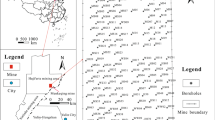Abstract
Against a background of hydrodynamic conditions connected with abandoning of significant number of mines and vast water reservoirs forming within them, basic methods of the assessment of strength of safety pillars used in coal mines in the USCB are presented. In the light of geomechanical research and conditions in mines in the USCB, the paper indicates a possibility of verification of safety pillar dimensions. On the example of one of mines in the USCB conditions for safety pillars stability in complicated mining conditions are assessed. The author also proposes a methodology of attempt and safety zones indication for existing safety pillars which would simultaneously be safety zones for designed exploitation.
Similar content being viewed by others
References
P. Bukowski, J. Wagner, and A. Witkowski, “Use of void spaces in abandoned mines in the Upper Silesian Coal Basin (Poland),” in: Proceedings of the IMWA Symposium: Water in Mining Environments, Macoedizioni (Ed.), Cagliari, Italy (2007).
P. Bukowski, “Water storage capacity of rock mass in forecasting the flooding process of mine workings,” in: Proceedings of the 7th International Mine Water Association Congress: Mine Water and the Environment, Ustroń, Poland (2000).
P. Bukowski, “The water storage capacity of a carboniferous rock mass and its impact on the flooding process of mine workings in the Upper Silesian Coal Basin,” in: Archives of Mining Sciences, 47, No. 3, Warszawa — Kraków, Wyd. PWN (2002).
S. G. Aviershin, “Barrier pillars,” in: Mining — Encyclopedic Reference Book [in Russian], 2, Ugletekhizdat (1974).
E. Konstantynowicz, T. Bromek, T. Piłat, et al., “Wyznaczanie filarów bezpieczeństwa dla ograniczenia zagrożenia wodnego w kopalniach węgla kamiennego (Determination of safety pillars for limiting of water hazard in hard coal mines” [in Polish, abstract in English], Prace GIG, Komunikat, No. 615, (1974).
E. Konstantynowicz, “Metodyka badań, profilaktyka i zabezpieczenia wyrobisk górniczych w kopalniach węgla przed wdarciem się wody lub kurzawki (The methodology of research, preventive measures and protections of mine workings in coal mines against water inrush or quicksand [in Polish, abstract in English],” Przegląd Górniczy, No. 3 (1971).
B. Schmieder, “Développement et résultants de la protection contre l’eau karstique et les nappes captives,” Publications de lInstitut de Recherches Miniéres de Hongrie, No. 12 (1969).
B. Schmieder, “Same remarks to provide a more exact definition for the term exploiting layer,” in: Proceedings of the Conference on Safety in the Mining, Budapest (1970).
R. Krajewski, “Dklugość przedwiertów ustalających zagrożenie wodne wyrobisk górniczych (Length of borehole determining water hazard in mine workings) [in Polish], Przegląd Górniczy, No. 1 (1957).
H. Labasse, “Le calcul de la largeul á donner aux massifs de protection á laisser le long des exploitations inondées,” Annales des Mines le Belgique, No. 4 (1966).
V. M. Maksimov, Hydrogeologist’s Reference [in Russian], Nedra, Moscow (1967).
J. A. Hudson, E. T. Brown, and C. Fairhurst, “Shape of the complete stress-strain curve for rock,” in: Proceedings of the 13th Symposium on Rock Mechanics, Illinois, USA (1971).
Z. Li, Y. Sheng, and D. J. Reddish, “Rock strength reduction and its potential environmental consequences as a result of groundwater rebound,” in: Proceedings of the 9th International Mine Water Association Congress: Mine Water 2005 — Mine Closure, Oviedo, Spain (2005).
P. Bukowski and M. Bukowska, “Zmiany niektórych wklasności środowiska geologicznego w strefie wahań zwierciadkla wód w zbiornikach tworzonych w kopalniach węgla kamiennego w GZW (Changes of some properties of geological environment within the zone of water table fluctuations in reservoirs formed in hard coal mines in the USCB’ [in Polish, abstract in English], in: Wspóklczesne Problemy Hydrogeologii,. Wyd. Uniwersytetu Mikoklaja Kopernika, A. Sadurski, A. Krawiec (Eds.), 12, Toruń (2005).
P. Bukowski and M. Bukowska, “Changes in geomechanical properties of carboniferous rocks under the influence of water and their possible consequences in the areas of abandoned mines of the Upper Silesian Coal Basin (Poland),” in: Proceedings of the 10th International Mine Water Association Congress: Mine Water and the Environments, Karlovy Vary (2008).
M. Bukowska (Ed.), Complex Method of the Assessment of Rock Mass Susceptibility to Bums in the Upper Silesian Coal Basin [in Polish], Wydawnictwo GIG, Katowice (2009).
M. Bukowska, “Mechanical properties of Carboniferous rocks in the Upper Silesian Coal Basin under uniaxial and triaxial compression tests,” Journal of Mining Science, 41, No. 2, (2005).
M. Bukowska, “The probability of rockburst occurrence in the Upper Silesian Coal Basin area dependent on natural mining conditions,” Journal of Mining Science, 42, No. 6 (2006).
M. Bukowska “The exploitation depth and bump hazard in the mines of the Upper Silesian Coal Basin,” in: Deep Mining Challenges. International Mining Forum 2009, E. J. Sobczyk, J. Kicki, and P. Sakluga (Eds.), CRC Press Taylor and Francis Group/Balkema (2009).
F. Vigh, “Dimensionierung der Wasserschutzpieiler,” Mitteilungen des Ungarischen Forshungsinstitutes fur Bergbau, No. 7. (1963–1964).
P. Bukowski, “Determining of water hazard zones for mining exploitation planned in the vicinity of reservoirs in abandoned mines,” Mineral Resources Management, 25, Zeszyt 3, Wydawnictwo Sigmie PAN Kraków, (2009).
P. Bukowski, “Relationship between renewable energy from low enthalpy mine waters stored in Polish hard coal mines and water hazard connected with plans of coal mining,” in: Proceedings of the International Mine Water Association Conference, Pretoria, South Africa (2009).
A. Kowalski, “Zmienność parametru zasięgu wpklywów gklównych w górotworze (Changeability of the parameter of main influence reach in rock mass” [in Polish], Ochrona Terenów Górniczych, No. 72/2 (1985).
Author information
Authors and Affiliations
Corresponding author
Rights and permissions
About this article
Cite this article
Bukowski, P. Determining of safety pillars in the vicinity of water reservoirs in mine workings within abandoned mines in the Upper Silesian Coal Basin (USCB). J Min Sci 46, 298–310 (2010). https://doi.org/10.1007/s10913-010-0037-2
Received:
Published:
Issue Date:
DOI: https://doi.org/10.1007/s10913-010-0037-2




